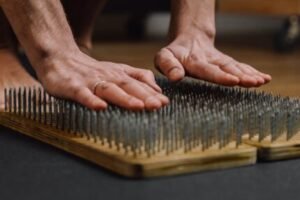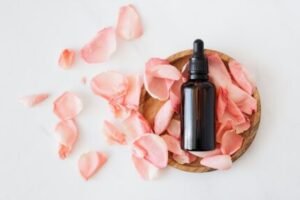Medically reviewed by Dr. Ramesh Gaddam, M.D. — Written by Sumalatha, D.N.H.E
Table of Contents
TogglePost-nap headaches (PNH) are headaches that occur after waking up from a nap.
These headaches can range from mild discomfort to intense pain and can affect daily activities and overall well-being.
They are different from headaches that occur after a full night’s sleep and may have specific triggers related to napping habits and the sleep environment.
1. Common Symptoms

Post-nap headaches can present various symptoms, including:
Throbbing or pulsating pain:
This type of pain often feels like a steady pulse or beat in the head.
Dull, aching pain:
A more consistent and less intense pain, often described as a tight band around the head.
Sensitivity to light and sound:
Bright lights and loud noises can exacerbate the headache.
Nausea or dizziness:
Some individuals may experience an upset stomach or a feeling of unsteadiness.
Neck and shoulder tension:
Muscle tension in these areas can accompany or even trigger headaches.
2. Types of Headaches

The types of headaches commonly associated with post-nap experiences include:
Tension headaches:
Often caused by stress, poor posture, or muscle strain, these headaches present as a band-like pressure around the head.
Migraine headaches:
Characterized by severe, throbbing pain, migraines can be triggered by various factors, including changes in sleep patterns.
Cluster headaches:
These are less common but can be very severe, often affecting one side of the head and occurring in cyclical patterns.
3. How Napping Affects the Body and Brain

Napping can significantly impact the body and brain, sometimes resulting in headaches. Key factors include:
Sleep inertia:
Waking up from a nap, especially from a deep sleep stage, can lead to sleep inertia, a state of grogginess and disorientation.
This can trigger headaches as the brain transitions from a state of rest to wakefulness.
Interrupted sleep cycles:
Naps that are too long or poorly timed can disrupt natural sleep cycles, leading to an imbalance in the body’s circadian rhythms.
This disruption can cause headaches as the body struggles to readjust.
Dehydration:
Often overlooked, dehydration can occur during sleep and contribute to headaches.
Not drinking enough water before napping can exacerbate this issue.
Blood sugar levels:
Changes in blood sugar levels can occur during naps, especially if the nap is taken on an empty stomach.
Low blood sugar can lead to headaches upon waking.
Muscle tension and posture:
Poor sleeping posture or tension in the neck and shoulders during a nap can lead to tension headaches.
Ensuring a comfortable and supportive sleeping position can help mitigate this risk.
Summary:
Understanding the mechanisms behind post-nap headaches is the first step in addressing and preventing them.
By recognizing the symptoms and types of headaches and the effects of napping on the body and brain, individuals can take proactive measures to reduce the occurrence of these uncomfortable episodes.
4. Causes of Post-Nap Headaches

Napping should refresh and energize you, but waking up with a headache can be frustrating and ruin your day.
Understanding the causes of post-nap headaches and knowing how to get rid of them is essential.
Dehydration
One of the most common causes of post-nap headaches is dehydration.
During sleep, the body loses water through breathing and sweat.
If you are already slightly dehydrated before napping, this can lead to a headache upon waking.
Dehydration reduces blood flow and oxygen to the brain, which can trigger pain receptors and result in a headache.
Tips to Prevent Dehydration:
- Drink a glass of water before taking a nap.
- Maintain good hydration habits throughout the day.
- Keep a water bottle by your bedside to sip on if you wake up during the night or from a nap.
Sleep Environment and Posture
Your sleep environment and posture play a crucial role in preventing post-nap headaches.
A poorly designed sleep environment or awkward sleeping posture can lead to muscle strain, especially in the neck and shoulders, which can result in tension headaches.
Optimizing Sleep Environment and Posture:
- Use a comfortable pillow that supports the natural curve of your neck.
- Ensure your mattress is supportive and not causing any misalignment in your spine.
- Create a sleep-friendly environment: dark, quiet, and cool.
Sleep Inertia and Sleep Cycles
Sleep inertia refers to the groggy, disoriented feeling that can occur upon waking, particularly if you wake up during the deep stages of sleep.
This disorientation can lead to headaches as your body struggles to transition from sleep to wakefulness.
Understanding sleep cycles is key to minimizing sleep inertia.
Managing Sleep Cycles:
- Aim for short naps of 20-30 minutes to avoid entering deep sleep stages.
- If you need a longer nap, aim for about 90 minutes to complete a full sleep cycle.
- Wake up at consistent times to help regulate your body’s internal clock.
Caffeine Withdrawal
Caffeine is a common stimulant that many people rely on to stay alert.
However, if you nap during the time your body expects a dose of caffeine, you might experience withdrawal symptoms, including headaches.
Tips to Manage Caffeine Intake:
- Gradually reduce caffeine consumption to prevent withdrawal symptoms.
- Avoid consuming caffeine late in the day to minimize disruptions to your sleep.
- If you regularly consume caffeine, plan your naps around your intake schedule.
Stress and Tension
Stress and tension are significant contributors to headaches, including those occurring after naps.
Stress can cause muscle tension, particularly in the neck and shoulders, leading to tension headaches.
Additionally, stress hormones can affect sleep quality, making post-nap headaches more likely.
Managing Stress and Tension:
- Practice relaxation techniques such as deep breathing, meditation, or yoga before napping.
- Create a relaxing pre-nap routine to calm your mind and body.
- Ensure your sleep environment is conducive to relaxation, free from stressors and distractions.
Summary:
By understanding these common causes of post-nap headaches, you can take proactive steps to prevent them.
Maintaining good hydration, optimizing your sleep environment and posture, managing sleep cycles, being mindful of caffeine intake, and addressing stress and tension are all effective strategies to reduce the occurrence of post-nap headaches.
5. Immediate Relief Techniques

When a post-nap headache strikes, finding quick and effective relief is essential.
Here are some immediate techniques to alleviate the pain and help you feel better fast.
1. Hydration:
One of the simplest and most effective ways to relieve a headache is to ensure you are properly hydrated. Dehydration is a common trigger for headaches, so drinking water can help alleviate the pain.
Steps to Rehydrate:
- Drink a full glass of water as soon as you wake up from your nap.
- Continue to sip water throughout the day to maintain hydration.
- Avoid excessive consumption of diuretics like caffeine and alcohol, which can dehydrate you.
2. Gentle Stretching and Light Exercise
Physical activity can help reduce headache symptoms by increasing blood flow and relieving muscle tension.
Gentle stretching and light exercise are particularly effective in addressing tension headaches caused by muscle strain.
Neck Stretch:
Slowly tilt your head to one side, bringing your ear towards your shoulder.
Hold for 15-30 seconds and repeat on the other side.
Shoulder Shrugs:
Raise your shoulders towards your ears, hold for a few seconds, and then release. Repeat several times.
Light Walking:
A short walk can help improve circulation and reduce headache severity.
3. Relaxation Techniques:
Stress and tension are common contributors to headaches.
Practicing relaxation techniques such as deep breathing and meditation can help calm your mind and reduce headache intensity.
Deep Breathing:
Sit or lie down in a comfortable position. Take a slow, deep breath in through your nose, allowing your abdomen to rise.
Exhale slowly through your mouth. Repeat for several minutes.
Meditation:
Find a quiet space and focus on your breath or a calming image.
Allow your mind to relax and release any tension.
4. Applying a Cold or Warm Compress
Temperature therapy can be an effective way to alleviate headache pain. Depending on the type of headache, applying a cold or warm compress can provide relief.
Temperature Therapy:
Place a cold pack or a cloth soaked in cold water on your forehead or the back of your neck.
Cold therapy helps constrict blood vessels and reduce inflammation.
Use a warm towel or heating pad on your neck and shoulders to relax tense muscles.
Warmth can help ease tension headaches and improve blood flow.
5. Over-the-Counter Pain Relief Options
When natural remedies aren’t enough, over-the-counter (OTC) pain relief medications can provide quick relief from post-nap headaches.
Common OTC options include:
Common OTC Pain Relievers:
- Acetaminophen (Tylenol): Effective for mild to moderate headaches.
- Ibuprofen (Advil, Motrin): Reduces inflammation and is helpful for tension and migraine headaches.
- Aspirin: Works well for various types of headaches, but should be used with caution if you have certain medical conditions or are on other medications.
Usage Tips:
- Always follow the dosage instructions on the label.
- Avoid frequent use of OTC pain relievers to prevent rebound headaches.
- Consult a healthcare professional if you have any concerns or if headaches persist.
By incorporating these immediate relief techniques, you can effectively manage and reduce the intensity of post-nap headaches.
Hydration, gentle stretching, relaxation, temperature therapy, and OTC pain relievers offer a comprehensive approach to finding quick and lasting relief.
6. Preventative Measures

Preventing post-nap headaches requires a proactive approach to your overall sleep and lifestyle habits.
Implementing the following preventative measures can help you reduce the likelihood of experiencing headaches after napping.
Establishing a Regular Sleep Schedule
Maintaining a consistent sleep schedule is essential for regulating your body’s internal clock, or circadian rhythm.
Irregular sleep patterns can disrupt your natural sleep cycles and increase the risk of headaches.
Tips for a Regular Sleep Schedule:
- Go to bed and wake up at the same time every day, even on weekends.
- Aim for 7-9 hours of sleep per night to ensure adequate rest.
- Avoid drastic changes to your sleep schedule, as this can disrupt your circadian rhythm.
Optimizing Nap Length and Timing
The duration and timing of your naps can significantly impact how you feel afterward.
Shorter naps are generally less likely to cause headaches, while longer naps can disrupt sleep cycles and lead to sleep inertia.
Optimal Nap Strategies:
- Limit naps to 20-30 minutes to avoid entering deep sleep stages, which can cause grogginess and headaches.
- If you need a longer nap, aim for about 90 minutes to complete a full sleep cycle.
- Schedule naps earlier in the day to prevent interference with nighttime sleep.
Creating a Comfortable Sleep Environment
Your sleep environment plays a crucial role in the quality of your rest.
A comfortable and conducive sleep setting can help prevent post-nap headaches.
Creating a Sleep-Friendly Environment:
Ensure your sleeping area is dark, quiet, and cool. Consider using blackout curtains and white noise machines if necessary.
Use a supportive pillow and mattress to maintain proper alignment and reduce muscle strain.
Keep electronic devices out of the bedroom to minimize distractions and improve sleep quality.
Managing Stress and Anxiety
Stress and anxiety are significant contributors to headaches.
Developing effective stress management techniques can help prevent tension headaches after napping.
Stress Management Techniques:
- Practice mindfulness meditation or deep breathing exercises to reduce stress levels.
- Engage in regular physical activity, such as yoga or walking, to release tension.
- Establish a relaxing pre-nap routine to calm your mind and body before resting.
Reducing Caffeine and Sugar Intake
Excessive consumption of caffeine and sugar can lead to headaches.
Managing your intake of these substances can help prevent post-nap headaches.
Caffeine and Sugar Management:
- Limit caffeine consumption, especially in the afternoon and evening, to prevent sleep disruption.
- Choose healthier alternatives to sugary snacks, such as fruits or nuts, to maintain stable blood sugar levels.
- Gradually reduce your dependence on caffeine to avoid withdrawal headaches.
Summary:
By incorporating these preventative measures into your daily routine, you can significantly reduce the risk of post-nap headaches.
Establishing a regular sleep schedule, optimizing nap length and timing, creating a comfortable sleep environment, managing stress and anxiety, and reducing caffeine and sugar intake are all effective strategies to help you wake up feeling refreshed and headache-free.
7. Long-Term Strategies

Adopting long-term strategies can help minimize the frequency and severity of headaches, including those that occur after naps.
Here are some effective approaches to consider.
Consistent Hydration Habits
Maintaining proper hydration is essential for overall health and can help prevent headaches.
Dehydration reduces blood flow and oxygen to the brain, which can trigger headaches.
Hydration Tips:
Aim to drink at least 8 glasses of water per day.
Carry a reusable water bottle to ensure you have access to water throughout the day.
Incorporate hydrating foods into your diet, such as fruits and vegetables with high water content (e.g., cucumbers, watermelon, oranges).
Regular Physical Activity
Engaging in regular physical activity can help reduce the frequency of headaches by improving circulation, reducing stress, and promoting better sleep.
Exercise Recommendations:
Aim for at least 150 minutes of moderate-intensity aerobic exercise or 75 minutes of vigorous-intensity exercise each week.
Include strength training exercises at least two days per week.
Incorporate activities that promote relaxation and flexibility, such as yoga or tai chi.
Balanced Diet and Nutrition
A well-balanced diet rich in essential nutrients can help prevent headaches by stabilizing blood sugar levels and providing the necessary vitamins and minerals for optimal brain function.
Nutritional Guidelines:
Eat regular, balanced meals that include a variety of fruits, vegetables, whole grains, lean proteins, and healthy fats.
Avoid skipping meals, as this can lead to low blood sugar and trigger headaches.
Limit processed foods, excessive sugar, and artificial additives, which can contribute to headaches.
Stress Management Techniques
Chronic stress is a common trigger for headaches.
Developing effective stress management techniques can help you manage and reduce stress, leading to fewer headaches.
Stress Reduction Strategies:
Practice mindfulness meditation or deep breathing exercises daily to promote relaxation.
Engage in hobbies and activities that bring you joy and relaxation.
Consider seeking professional support, such as therapy or counseling, if stress is significantly impacting your life.
Sleep Hygiene and Routines
Good sleep hygiene and consistent routines can improve sleep quality and reduce the likelihood of headaches.
Prioritizing restful sleep is crucial for overall well-being.
Sleep Hygiene Tips:
Establish a consistent bedtime routine that signals your body it’s time to wind down.
Avoid electronic screens at least an hour before bedtime to reduce exposure to blue light, which can interfere with sleep.
Create a relaxing bedtime environment by keeping your bedroom cool, dark, and quiet.
Avoid large meals, caffeine, and alcohol close to bedtime, as these can disrupt sleep.
Summary:
Consistent hydration, regular physical activity, a balanced diet, stress management, and good sleep hygiene are all essential components of a holistic approach to headache prevention and overall health.
8. When to Seek Medical Advice

While many post-nap headaches can be managed with lifestyle adjustments and immediate relief techniques, some cases may require medical attention.
Understanding when to seek medical advice is crucial for identifying potential underlying issues and obtaining appropriate treatment.
Frequent headaches:
If you experience headaches more often than usual, especially if they interfere with your daily activities.
Severe pain:
If your headaches are extremely painful and do not respond to over-the-counter medications or other relief techniques.
Associated symptoms:
If your headaches are accompanied by other symptoms such as vision changes, confusion, dizziness, numbness, or weakness.
Headaches after injury:
If you develop headaches after a head injury or trauma.
Medication overuse:
If you find yourself needing to use pain relief medications more frequently than recommended, as this can lead to rebound headaches.
9. Alternative Remedies

For those seeking natural or holistic approaches to headache relief, alternative and complementary remedies can be effective.
These methods can be used alongside conventional treatments or as stand-alone options.
Herbal Remedies and Supplements
Many people turn to herbal remedies and dietary supplements to alleviate headaches.
Some herbs and supplements have been shown to provide relief from headache symptoms. Popular Herbal Remedies and Supplements are:
Feverfew:
This herb has been traditionally used to prevent and treat migraines. It may help reduce the frequency and severity of headaches.
Butterbur:
Another herb that has shown promise in preventing migraines. Ensure you use a purified form to avoid potential liver toxicity.
Magnesium:
A deficiency in magnesium has been linked to migraines. Taking a magnesium supplement can help reduce headache frequency.
Riboflavin (Vitamin B2):
High doses of riboflavin have been found to reduce the frequency of migraines.
Peppermint oil:
Applied topically, peppermint oil can provide relief from tension headaches due to its cooling and analgesic properties.
Usage Tips:
Consult with a healthcare professional before starting any new supplement to ensure it’s safe for you.
Follow recommended dosages and be aware of potential side effects or interactions with other medications.
10. Acupuncture and Massage Therapy

Acupuncture and massage therapy are widely used alternative treatments for headache relief.
These therapies focus on promoting relaxation, improving circulation, and reducing muscle tension.
Acupuncture:
Acupuncture involves the insertion of thin needles into specific points on the body.
It is believed to balance the body’s energy flow and stimulate natural pain-relieving mechanisms.
Studies have shown that acupuncture can be effective in reducing the frequency and severity of migraines and tension headaches.
Massage Therapy:
Massage therapy can help relieve muscle tension, improve circulation, and promote relaxation, all of which can alleviate headache symptoms.
Techniques such as deep tissue massage, trigger point therapy, and craniosacral therapy are particularly beneficial for tension headaches.
Finding a Practitioner:
Seek out licensed and experienced acupuncturists or massage therapists.
Communicate your headache symptoms and any other health concerns to ensure personalized treatment.
11. Aromatherapy and Essential Oils

Aromatherapy involves using essential oils to promote relaxation and well-being.
Certain essential oils have properties that can help relieve headache symptoms.
Effective Essential Oils:
- Lavender oil: Known for its calming effects, lavender oil can help reduce stress and tension, which are common headache triggers.
- Peppermint oil: The cooling effect of peppermint oil can help soothe tension headaches when applied to the temples and forehead.
- Eucalyptus oil: This oil can help relieve sinus-related headaches by reducing inflammation and clearing nasal passages.
Application Methods:
- Inhalation: Add a few drops of essential oil to a diffuser or a bowl of hot water and inhale the steam.
- Topical application: Dilute essential oils with a carrier oil (such as coconut or almond oil) and apply to the temples, neck, and shoulders.
- Bath: Add a few drops of essential oil to a warm bath for a relaxing and therapeutic experience.
12. Mindfulness and Cognitive-Behavioral Therapy
Mindfulness and cognitive-behavioral therapy (CBT) are effective psychological approaches to managing headaches, particularly those triggered by stress and anxiety.
Mindfulness Practices:
Practicing mindfulness meditation can help reduce stress, improve focus, and promote relaxation, which can reduce headache frequency and severity.
Deep breathing exercises can help calm the mind and body, providing relief from tension headaches.
Cognitive-Behavioral Therapy:
This form of therapy helps individuals identify and change negative thought patterns and behaviors that contribute to stress and headaches.
CBT can teach effective coping strategies to manage stress and reduce headache triggers.
Finding a Therapist:
Look for licensed therapists who specialize in CBT and mindfulness-based therapies.
Many therapists offer both in-person and virtual sessions, providing flexibility for treatment.
Summary:
By exploring these alternative and complementary remedies, you can find additional strategies to manage and reduce headache symptoms.
Herbal remedies and supplements, acupuncture and massage therapy, aromatherapy and essential oils, and mindfulness and cognitive-behavioral therapy offer diverse approaches to holistic headache relief.
Frequently Asked Questions
People searched frequently about Post Nap Headaches are:
Why Do I Get a Headache After I Wake Up from a Nap?
Waking up with a headache after a nap can be frustrating.
Several factors contribute to post-nap headaches, including dehydration, poor sleep environment, sleep inertia, and muscle tension.
Understanding these causes can help you prevent and manage headaches effectively.
How to Get Rid of a Post-Nap Headache?
To alleviate a headache after a nap, start by drinking water to rehydrate.
Gentle stretching and light exercise can relieve muscle tension.
Applying a cold or warm compress to your forehead or neck, practicing deep breathing or meditation, and taking over-the-counter pain relief can also be effective.
How to Get Rid of Headaches After Sleeping?
If you wake up with a headache after sleeping, follow similar steps as for post-nap headaches.
Ensure you stay hydrated, create a comfortable sleep environment, and practice good sleep hygiene.
Regular physical activity and stress management techniques can also help reduce the frequency of these headaches.
How Do You Get Rid of a Sleepy Headache?
A sleepy headache often results from sleep inertia or disrupted sleep.
To get rid of it, drink water, perform gentle stretching, and consider a short walk to increase circulation.
A light snack with a balanced mix of protein and carbohydrates can also help stabilize blood sugar levels.
How to Stop a Headache Fast?
To stop a headache quickly, drink water and take an over-the-counter pain reliever like ibuprofen or acetaminophen.
Applying a cold compress to your forehead, practicing deep breathing exercises, or resting in a dark, quiet room can provide fast relief.
Can Oversleeping Cause a Headache?
Yes, oversleeping can cause headaches.
Excessive sleep can disrupt your sleep cycles, lead to sleep inertia, and affect neurotransmitter levels in the brain, which can trigger headaches. Maintaining a regular sleep schedule helps prevent this.
How Many Hours Is Oversleeping?
Oversleeping is generally defined as sleeping more than 9-10 hours per night on a regular basis.
This can vary slightly depending on individual needs and circumstances, but consistently sleeping more than this can lead to headaches and other health issues.
Is 10 Hours of Sleep Good?
For most adults, 7-9 hours of sleep per night is recommended.
While 10 hours may occasionally be needed, regularly sleeping this long can indicate an underlying health issue or contribute to problems like headaches.
Consult a healthcare provider if you consistently need 10 hours of sleep.
How to Recover from Sleeping Too Much?
To recover from oversleeping, start by establishing a consistent sleep schedule.
Gradually reduce your sleep time to the recommended 7-9 hours.
Engage in regular physical activity, maintain a balanced diet, and manage stress effectively.
Staying hydrated and creating a comfortable sleep environment will also support better sleep patterns.
References:
A Micro-Longitudinal Study of Naps, Sleep Disturbance, and Headache Severity in Women with Chronic Migraine
https://www.ncbi.nlm.nih.gov/pmc/articles/PMC9500108/
Also Read:
https://healthbuildup.com/chronic-fatigue-syndrome-causes/
Medically reviewed by Dr. Ramesh Gaddam, M.D.

General Physician, Diabetologist, and Critical Care Specialist.
Related
Discover more from Health Build-Up
Subscribe to get the latest posts sent to your email.
